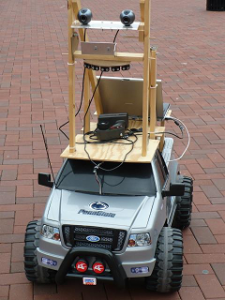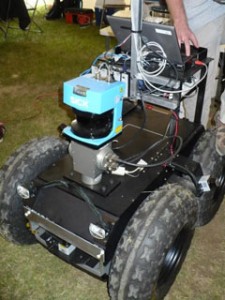For any of those interested, I wrote a little article on some of my robotics research done over the last few years. I haven’t included the Windows Phone 7 testing platform, but focused on some of the competitive aspects of my experience.
Mini Grand Challenge
Modeled after the DARPA Grand Challenge, the Mini Grand Challenge is an outdoor autonomous vehicle competition hosted by the Abington branch campus of the Pennsylvania State University. The Mini Grand Challenge consists of two parts. In part 1, the robot has to stay on an asphalt path while navigating through a series of waypoints. If an obstacle is detected, the robot must stop within 2 feet and wait for the obstacle to be removed. Branches in the path are blocked with orange cones. In part 2, the robot must move off the path and navigate towards a final GPS waypoint and stop within 30 feet of that location. In this stage of the competition, the robot must navigate around any obstacles it encounters. Scoring for the competition is based on a number of different criteria, including total waypoints reached by the robot and also through crowd interaction. There are also several mandatory sub-tasks: The robot must stay within 1 to 5 MPH as well as carry one gallon of water. The vehicle may support crowd interaction (voice, conversation, music, etc..) for bonus points.
The Penn State Robotics Club has a modified Power-Wheels chassis that is used as the vehicle base, interfaced with an Arduino microcontroller. Other hardware components included are a laser-range finder, cameras, GPS, compass, wheel encoders, and on-board computers.
Source code:
International Ground Vehicle Competition – IGVC
The IGVC, or Intelligent Ground Vehicle Competition, is a competition held every year by the Association for Unmanned Vehicle Systems International (AUVSI). This student competition is one of four the AUVSI holds each year to challenge students to develop unmanned vehicle systems. This competition is held every spring by the AUVSI. Each year, as many as 50 teams come out from universities across the country, to compete in the four “challenges” that comprise the competition. Each of the four challenges is scored individually, and the combined results are used to determine the overall winner.
The Navigation challenge tests a robot’s ability to navigate to pre-defined waypoints through treacherous terrain. The robot is placed in an obstacle course and given one corner coordinate and the dimensions of the course. The robot must navigate through the course and visit the given GPS waypoints, avoiding obstacles such as barrels, cones, potholes, and trash cans. Teams have a total of 6 minutes to navigate to as many of the 8 given waypoints as possible.
The Autonomous challenge tests a robot’s ability to navigate around obstacles while staying inside of a pre-defined lane. The course consists of a lane painted on the grass in white or yellow, with obstacles dispersed throughout. The robots must stay within the lane, which weaves and goes up and down ramps, while avoiding the obstacles in it’s path. Teams are judged based on how fast the robot is able to make it through the course, and how many rule infractions (exiting the lane, hitting obstacles) they make.
The Design challenge is a two-part challenge that documents the development and capabilities of each robot. Each team must submit a 15 page design report, highlighting the design process of the robot, as well as all capabilities and innovations of the robot platform. Then, during the weekend of the competition, each team is required to give a 30 minute presentation to the judges. This presentation is supposed to highlight the robot’s capabilities, and provide more detail as to the features and innovations that the robots posses.
Source code:
Genetic Algorithms
The purpose of this paper is to provide a plan for an Artificially Intelligent (AI) player for the classic game of Battleship. In order to accomplish this goal, the game is split into three logical areas: ship placement, targeting, and sinking strategy. This paper details the specific AI objectives for each area, as well as the implementation of an intelligent system using genetic algorithms. This artificially intelligent player will be tested in a competition against other artificially intelligent battleship opponents.
RoboWiki
The Pennsylvania State University, University Park Robotics Club is an organization created to educate members, as well as compete in several challenges, on the subject of autonomous robotics. As the group has grown over the years, the need for clear documentation to aid the development cycle as well as enable members to re-use past technologies is greatly needed. The past club’s website lacked the ability to share media both internally with other members, as well as with the public. The solution was to enable the sharing of user generated content as well as a pragmatic approach to the front-end that enables administrators to release information and media without any technical knowledge or extra tools apart from a web browser and account access.
The current solution was a custom installation of the MediaWiki application onto the robotics club, now titled the RoboWiki.

